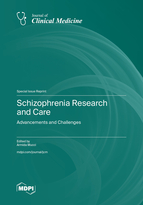Schizophrenia Research and Care—Advancements and Challenges
A special issue of Journal of Clinical Medicine (ISSN 2077-0383). This special issue belongs to the section "Mental Health".
Deadline for manuscript submissions: closed (15 December 2022) | Viewed by 30117
Special Issue Editor
Interests: electrophysiological, brain imaging and neuropsychological correlates of negative symptom domains in schizophrenia; cognitive remediation in schizophrenia; clinical, biological and social aspects influencing schizophrenia real-life functioning
Special Issue Information
Dear Colleagues,
The diagnosis and care of people with schizophrenia has improved in the last several decades, but schizophrenia remains a leading cause of disability and premature mortality.
In more than 50% of affected individuals, currently available antipsychotics are poorly tolerated or ineffective in ameliorating positive psychotic symptoms (delusions and hallucinations).
The treatment of cognitive impairment and negative symptoms, which represent the main determinants of disability, remains an unmet need of schizophrenia care.
Finally, antipsychotics might worsen the highly prevalent physical health problems of people with schizophrenia, such as cardiovascular disease and metabolic syndrome, contributing to their disability and reduced life expectancy.
The progress In understanding the neurobiology of schizophrenia has fostered the development of novel dopaminergic and non-dopaminergic antipsychotics which hold promise for the improvement of treatment-resistant positive symptoms, negative symptoms and cognitive impairment. Furthermore, some new antipsychotics present a substantial reduction of liability to represent cardiovascular and metabolic risk factors.
Cognitive remediation has been shown to be an effective intervention to improve cognitive dysfunction in schizophrenia, and might ameliorate negative symptoms. Other psychosocial interventions have shown beneficial effects on negative symptoms, but it is not clear whether these effects are specific or reflect improvement in other dimensions.
Innovative non-pharmacological interventions are under scrutiny for treatment-resistant psychotic symptoms, such as those using virtual reality for hallucinations.
The integration of pharmacological and psychosocial interventions heavily depends on accurate and comprehensive assessment of psychopathology, cognitive profile, and physical health status, with the potential to improve the quality of life of people with schizophrenia.
This Special Issue of the Journal of Clinical Medicine on Schizophrenia Research and Care—Advancements and Challenges aims to collect reviews, original research articles, opinion papers, to provide updates, new findings and future perspectives of schizophrenia research and care.
Topics will include
1) Cognitive impairment associated with schizophrenia: the role of social and non-social deficits;
2) New perspectives of cognitive remediation in schizophrenia;
3) Biomarkers of cognitive dysfunction and negative symptoms;
4) Challenges and advancements in the assessment of negative symptoms;
5) Physical health in people with schizophrenia and antipsychotic treatment;
6) Virtual reality in the assessment and care of people with schizophrenia;
7) New dopaminergic and non-dopaminergic antipsychotics: from improved tolerability to improved efficacy.
Prof. Dr. Armida Mucci
Guest Editor
Manuscript Submission Information
Manuscripts should be submitted online at www.mdpi.com by registering and logging in to this website. Once you are registered, click here to go to the submission form. Manuscripts can be submitted until the deadline. All submissions that pass pre-check are peer-reviewed. Accepted papers will be published continuously in the journal (as soon as accepted) and will be listed together on the special issue website. Research articles, review articles as well as short communications are invited. For planned papers, a title and short abstract (about 100 words) can be sent to the Editorial Office for announcement on this website.
Submitted manuscripts should not have been published previously, nor be under consideration for publication elsewhere (except conference proceedings papers). All manuscripts are thoroughly refereed through a single-blind peer-review process. A guide for authors and other relevant information for submission of manuscripts is available on the Instructions for Authors page. Journal of Clinical Medicine is an international peer-reviewed open access semimonthly journal published by MDPI.
Please visit the Instructions for Authors page before submitting a manuscript. The Article Processing Charge (APC) for publication in this open access journal is 2600 CHF (Swiss Francs). Submitted papers should be well formatted and use good English. Authors may use MDPI's English editing service prior to publication or during author revisions.
Keywords
- cognitive impairment
- negative symptoms
- treatment-resistant schizophrenia
- non-dopaminergic antipsychotics
- premature mortality
- cognitive remediation
- virtual reality







